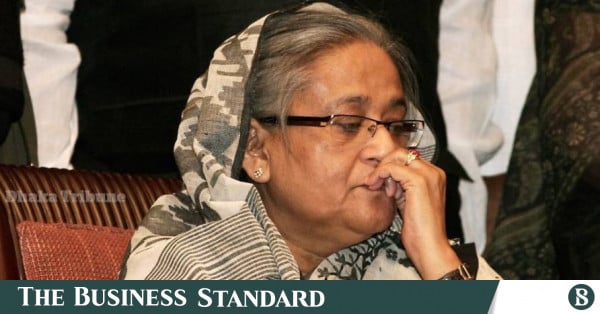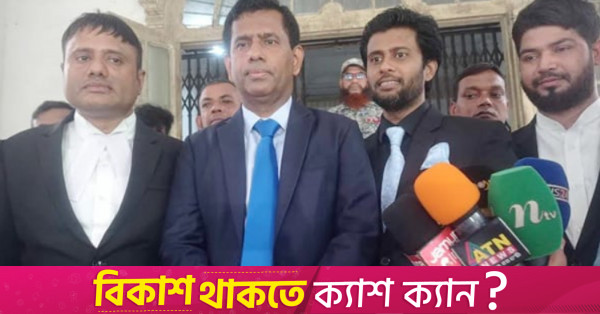Pressure was mounting. Students had the final whistle. A part of law enforcers were indecisive. The last defense's message is loud and clear: they are with people for the country's interest.
Still, it was like any other morning.
Obviously, it was not like one of the mornings before mid-July when a government services' quota reform movement started to witness bloodshed, which would later turn into a one-point movement. But it should have been one like the previous day or the day before.
Tension was all around. Risk everywhere. A wait for the climax at home and abroad.
But, she did not think the day had come.
Like other mornings, on 5 August, she had an early wake-up despite a late night sleep, which was too late. After her morning prayers with a lengthy doa, she sat in her office room inside Ganobhaban with a cup of tea.
Her security personnel were all around. A number of her personal wing officials had already reached.
Ganobhaban, the official residence of the country's prime minister, remained heavily guarded by members of different forces alongside the elite SSF (Special Security Force) and PGR (President Guard Regiment).
She started calling her trusted top officials in police and other forces.
As a pre-dawn curfew was already in place, they assured her of stern action against curfew violators. Also, a total cessation of all entry points of the capital was assured.
She had her breakfast and a query about the day's food items. Many important persons -- from the political arena to civil society as well as top officials -- are scheduled to visit her on her call or invitation or by themselves.
By that time, a journalistic visit outside Ganobhaban at 9am found a quiet situation around.
Security around the PM's official residence was visibly tight compared to previous days. But, surprisingly, vehicular movement was allowed. Even rickshaws or battery-run autos could also ply.
Bangabandhu Memorial Museum, only a few minutes' drive from Ganobhaban, was also found to be heavily guarded.
The activists of Awami League, Chhatra League and Swechchhasebak League, who carried out mayhem across the country the previous day and guarded the road from Ganobhaban to Dhanmondi 32 on the previous days, many of whom in helmets, were not seen anywhere.
People thought they would arrive in an hour.
Many officegoers were on the streets despite the imposition of a total curfew. Dhaka Metropolitan Police (DMP) had a warning the previous night that the the toughest of actions would be taken against curfew violators, imposed indefinitely.
After a 10-minute drive from Bangabandhu Museum to the Hotel Intercontinental intersection, an interception was noticed. All the vehicles were diverted through the tiny road beside Sakura Bar and Restaurant.
Some say tanks, and some say armored personnel careers (APC), were seen in front of Intercontinental. Those were not faced towards the Shahbagh crossing, where protesters were expected to throng.
The tanks/APCs were facing towards Bangla Motor crossing, which was an unusual gestureure, though.
After another 10 minutes, several people were seen at Central Shaheed Minar inside Dhaka University campus. Already, a good number of people had gathered there.
Many more were gathering at the nearby Chankharpool area where a class ten student, among others, would be killed after some time.
Then, a visit to the National Press Club area found an all-quiet situation. Metro station, too, was soundless as metro operations had been suspended for two weeks.
Proceeding further, DB men were found brandishing weapons and intercepting vehicles, as well as ordinary people trying to cross the DMP headquarters.
Inside nearby Minto Road-Hare Road' Montreepara', where ministers and topmost government officials reside, was also found to be silent.
Only some workers were seen painting the outside walls of the Chief Justice's residence. Protesters had written many things on the walls in the past few days.
During the morning visit, similar wall writings were found everywhere in the capital. Those read mainly "killer Hasina", "autocrat Hasina" and "step down Hasina".
Sheikh Hasina was, by then, holding meetings with senior security officials at Ganobhaban. News leaked through several confidential sources indicated something big was going to happen.
"It is going to be a different day," a source indicated to TBS.
She had taken the previous day from the security forces to quell down the movement using her own party men. It backfired. Movement intensified further, and there were more casualties from both sides.
On the same day, the Anti-Discrimination Students' Movement announced the "march to Dhaka" on 5 August, although it was scheduled for 6 August earlier. They had an announcement to march towards Ganobhaban, too.
It worked.
Two days before (3 August), the army had an "officer's address" and the Chief of Army Staff told the meeting that the armed forces will be beside people and in the interest of the country.
A decision was also taken that army personnel deployed on 20 July would not open fire on countrymen.
The same day (3 August), people from all walks of life thronged the streets, indicating a mass upsurge was imminent.
All of it worked together on 5 August.
By 10:30am, Sheikh Hasina called the top brasses of the security forces. They rushed as it was their desire to meet the prime minister as well.
They joined the meeting with intelligence reports that Dhaka was about to collapse like that of 16 December 1971.
The difference is that the joint forces of Bangladesh's freedom fighters and the Indian army had encircled the occupation of the Pakistani army in Dhaka at that time. Now, ordinary people.
She blasted the security forces for their "failure" and ordered to resist the people.
The forces declined to avert further bloodshed.
Although a leader who had emerged from the ashes to the country's longest-serving head of government couldn't read people's power, the forces perhaps could.
They argued it would cause more casualties. There will be a sea of blood but no assurance of keeping people away from the Ganobhaban.
They presented the intelligence reports that lakhs of people are at the entry points of the capital. Police have already killed many of them at Jatrabari, Savar, Ashulia, and Uttara. The death toll only this morning is about 100.
DMP's command center was still in operation.
Senior police officers were sending directives to the field level to stop people from entering the capital. But their top official at the meeting informed the PM it's a matter of only an hour or two, if not minutes.
The situation was that Sheikh Hasina had only one alternative: resignation.
Initially, she declined.
She rebuked the officers, saying she had made them and taken them to the helm of today's position. Now they are not protecting the government and the "state".
Frustrated by her reaction, top officers talked to her sister, Sheikh Rehana, in a different room at Ganobhaban. Rehana spoke to her, she still could not convince Hasina.
Then her son Sajeeb Wazed Joy, who lives in the USA, was called. He talked with the officers about their "failure" to protect an incumbent government.
But, finally, he understood the gravity of the situation. Joy then talked to his mother.
Sheikh Hasina is now convinced. But, she wanted to visit Dhanmondi 32 and Gopalganj and pay tribute to the father of the nation.
Officers were convinced it would create fresh troubles. They also had an apprehension that she could change her mind once she was in Tungipara, Gopalganj.
So, they refused.
Now, Hasina wanted to give an address to the nation.
State Minister for Information, who is a close friend of Joy and was still beside her, was asked to prepare a brief speech. He drafted it on his mobile phone or carried the draft from earlier.
Officers took fresh stock of gatherings around Dhaka and Shahbagh. Their calculation said the crowds are only 45 minutes away from Ganobhaban.
So, the proposal of recording a speech was denied.
The final address to the nation she could never make.
Sheikh Hasina, still Bangladesh's prime minister, called Indian Prime Minister Narendra Modi by satellite phone. She requested to send a flight to carry her to India.
Modi instantly committed.
But soon, he made a return call to explain that sending an aircraft without formal procedures would violate the international code. It will also linger on her departure.
So, a quick pack-up.
A pack-up of four suitcases for boarding at first a helicopter and then a
transport aircraft of Bangladesh Air Force towards India.
It was also a pack-up of a long political career that she had started returning from her exile life in India in 1981 after her father, Bangabandhu Sheikh Mujibur Rahman, was assassinated along with most of his family in 1975.
She resigned and flew to India.
Army guards were soon withdrawn from Ganobhaban and surrounding areas.
People reached Ganobhaban.
Sheikh Hasina, now Bangladesh's immediate past and longest-serving prime minister, was on board a transport aircraft.
Like other mornings, on 5 August, she had an early wake-up despite a late night sleep, which was too late. After her morning prayers with a lengthy doa, she sat in her office room inside Ganobhaban with a cup of tea

www.tbsnews.net






























































































